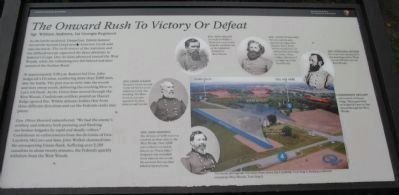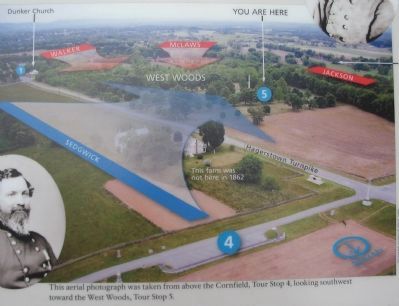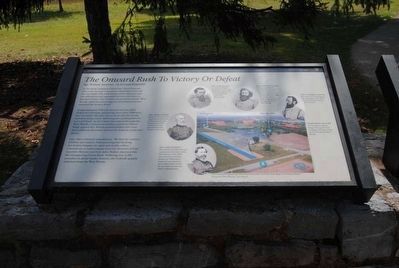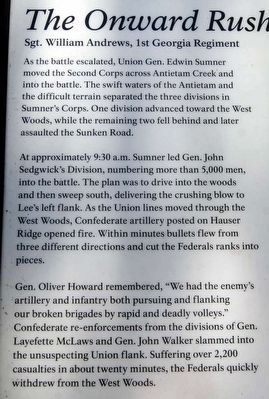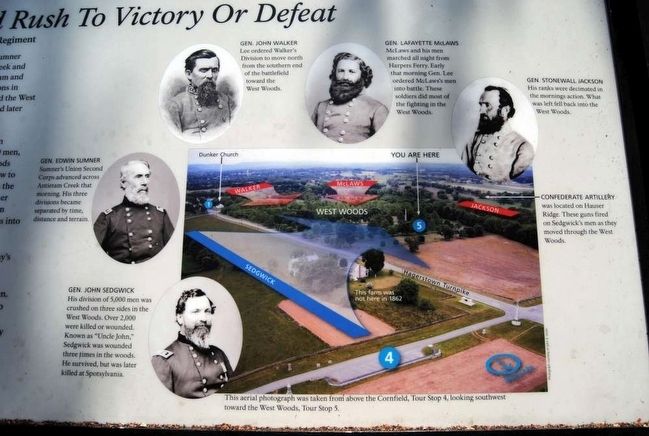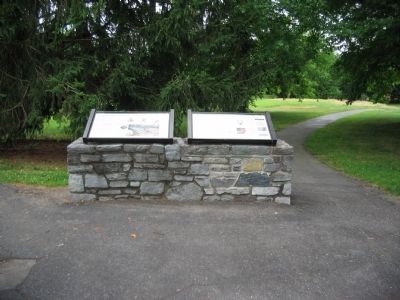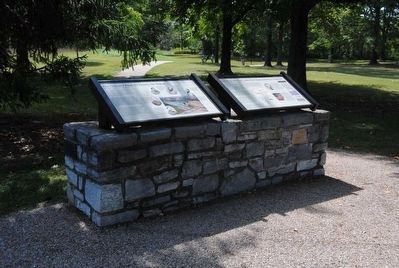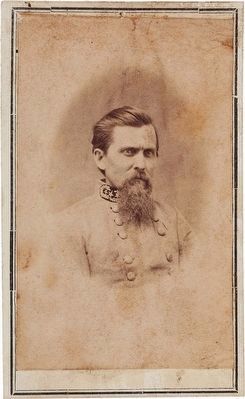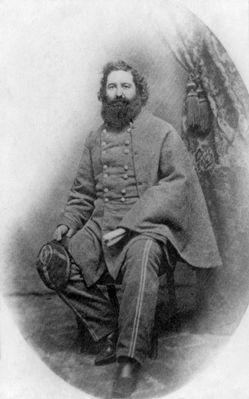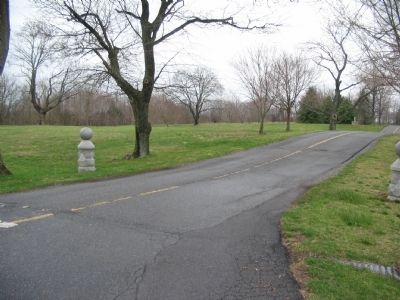Near Sharpsburg in Washington County, Maryland — The American Northeast (Mid-Atlantic)
The Onward Rush to Victory or Defeat
Inscription.
Sgt. William Andrews, 1st Georgia Regiment
As the battle escalated, Union Gen. Edwin Sumner moved the Second Corps across Antietam Creek and into the battle. The swift waters of the Antietam and the difficult terrain separated the three divisions in Sumner's Corps. One division advanced toward the West Woods, while the remaining two fell behind and later assaulted the Sunken Road.
At approximately 9:30 a.m. Sumner led Gen. John Sedgwick's Division, numbering more than 5,000 men, into the battle. The plan was to drive into the woods and then sweep south, delivering the crushing blow to Lee's left flank. As the Union lines moved through the West Woods, Confederate artillery posted on Hauser Ridge opened fire. Within minutes bullets flew from three different directions and cut the Federals ranks into pieces.
Gen. Oliver Howard remembered, "We had the enemy's artillery and infantry both pursuing and flanking our broken brigades by rapid and deadly volleys." Confederate re-enforcements from the divisions of Gen. Layefette McLaws and Gen. John Walker slammed into the unsuspecting Union flank. Suffering over 2,200 casualties in about twenty minutes, the Federals quickly withdrew from the West Woods.
(Captions next to portraits of the Generals):
Gen. Edwin Sumner
Sumner's Union Second Corps advanced across Antietam Creek that morning. His three divisions became separated by time, distance and terrain.
Gen. John Sedgwick
His division of 5,000 men was crushed on three sides in the West Woods. Over 2,000 were killed or wounded. Known as "Uncle John," Sedgwick was wounded three times in the woods. He survived, but was later killed at Spotsylvania.
Gen. John Walker
Lee ordered Walker's Division to move north from the southern end of the battlefield toward the West Woods.
Gen. Lafayette McLaws
McLaws and his men marched all night from Harpers Ferry. Early that morning Gen. Lee ordered McLaws's men into battle. These soldiers did most of the fighting in the West Woods.
Gen. Stonewall Jackson
His ranks were decimated in the mornings action. What was left fell back into the West Woods.
Confederate Artillery
was located on Hauser Ridge. These guns fired on Sedgwick's men as they moved through the West Woods.
Erected 2009 by Antietam National Battlefield - National Park Service - U.S. Department of the Interior.
Topics. This historical marker is listed in this topic list: War, US Civil. A significant historical date for this entry is September 17, 1862.
Location. 39° 28.697′ N, 77° 44.969′ W. Marker is near Sharpsburg, Maryland, in Washington County. Marker is on Dunker Church Road / Old Hagerstown Pike, on the right when traveling south. Located at stop five of the driving tour of Antietam Battlefield, near the Philadelphia Brigade monument. Touch for map. Marker is in this post office area: Sharpsburg MD 21782, United States of America. Touch for directions.
Other nearby markers. At least 10 other markers are within walking distance of this marker. "With Flags Flying" (here, next to this marker); "The Jaws of Death" (here, next to this marker); "Back Boys, For God's Sake Move Back;" (here, next to this marker); Philadelphia Brigade Monument (within shouting distance of this marker); "We May Never Meet Again" (within shouting distance of this marker); Philadelphia Brigade Park (within shouting distance of this marker); The Baltimore Battery (within shouting distance of this marker); Brigadier General William E. Starke (within shouting distance of this marker); a different marker also named Baltimore Battery (within shouting distance of this marker); Brockenbrough’s 2nd Baltimore, Maryland Battery (within shouting distance of this marker). Touch for a list and map of all markers in Sharpsburg.
More about this marker. On the right side of the marker is an aerial photograph with depictions of the unit movements, and keys to the park's tour stops. The aerial photograph was taken from above the Cornfield, Tour Stop 4, looking southwest toward the West Woods, Tour Stop 5.
Related marker. Click here for another marker that is related to this marker. This marker replaced an older one at this location titled "With Flags Flying."
Also see . . .
1. Antietam Battlefield. National Park Service site. (Submitted on July 8, 2009, by Craig Swain of Leesburg, Virginia.)
2. Edwin Vose Sumner. Edwin Vose Sumner (January 30, 1797 – March 21, 1863) was a career United States Army officer who became a Union Army general and the oldest field commander of any Army Corps on either side during the American Civil War. (Submitted on October 16, 2015, by Brian Scott of Anderson, South Carolina.)
3. John Sedgwick. John Sedgwick (September 13, 1813 – May 9, 1864) was a teacher, a career military officer, and a Union Army general in the American Civil War. He was the highest ranking Union casualty in the Civil War, killed by a sharpshooter at the Battle of Spotsylvania Court House, and is well-remembered for his ironic last words: "They couldn't hit an elephant at this distance." (Submitted on October 16, 2015, by Brian Scott of Anderson, South Carolina.)
4. John George Walker. John George Walker (July 22, 1821 – July 20, 1893) was a Confederate general in the American Civil War. (Submitted on October 16, 2015, by Brian Scott of Anderson, South Carolina.)
5. Lafayette McLaws. Lafayette McLaws (January 15, 1821 – July 24, 1897) was a United States Army officer and a Confederate general in the American Civil War. He served at Antietam and Fredericksburg, where Robert E. Lee praised his defense of Marye's Heights. (Submitted on October 16, 2015, by Brian Scott of Anderson, South Carolina.)
6. Stonewall Jackson. Thomas Jonathan "Stonewall" Jackson (January 21, 1824 – May 10, 1863) was a Confederate general during the American Civil War, and the best-known Confederate commander after General Robert E. Lee. (Submitted on October 16, 2015, by Brian Scott of Anderson, South Carolina.)
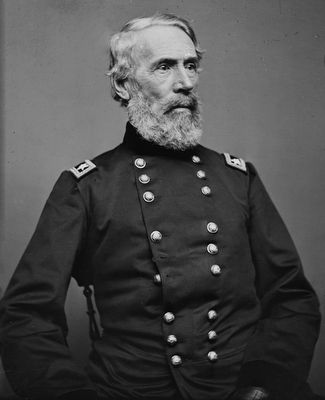
Photographed By Brian Scott
8. Major General Edwin Vose Sumner (1797–1863)
In the fall of 1862, at the Battle of Antietam, Sumner was the center of controversy for ordering Brig. Gen. John Sedgwick's division to launch an attack into the West Woods on the morning of the battle. The assault was devastated by a Confederate counterattack, and Sedgwick's men were forced to retreat in great disorder to their starting point with over 2,200 casualties.
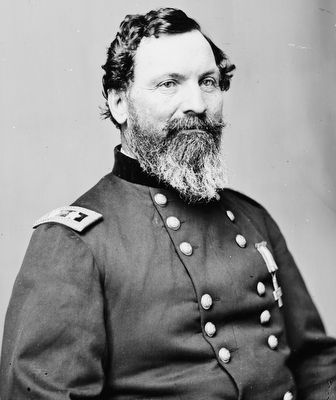
Photographed By Brian Scott
9. Major General John Sedgwick (1813-1864)
In the Battle of Antietam, II Corps commander Maj. Gen. Edwin V. Sumner impulsively sent Sedgwick's division in a mass assault without proper reconnaissance. His division was engaged by Confederate forces under Maj. Gen. Thomas J. "Stonewall" Jackson from three sides, was routed, and fell back with barely half the men it had started with. Sedgwick himself was hit by three bullets, in the wrist, leg, and shoulder.
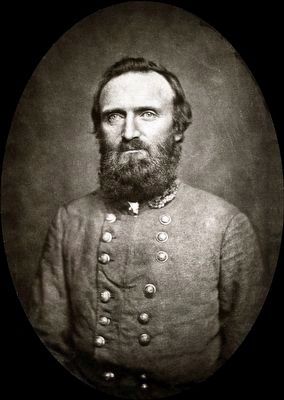
Photographed By Brian Scott
12. Lieut. General Thomas "Stonewall" Jackson (1824-1863)
Jackson's men bore the brunt of the initial attacks on the northern end of the battlefield and, at the end of the day, successfully resisted a breakthrough on the southern end when Jackson's subordinate, Maj. Gen. A. P. Hill, arrived at the last minute from Harpers Ferry. The Confederate forces held their position, but the battle was extremely bloody for both sides, and Lee withdrew the Army of Northern Virginia back across the Potomac River, ending the invasion.
Credits. This page was last revised on April 2, 2022. It was originally submitted on July 8, 2009, by Craig Swain of Leesburg, Virginia. This page has been viewed 1,126 times since then and 22 times this year. Photos: 1, 2. submitted on July 8, 2009, by Craig Swain of Leesburg, Virginia. 3, 4, 5. submitted on October 16, 2015, by Brian Scott of Anderson, South Carolina. 6. submitted on July 8, 2009, by Craig Swain of Leesburg, Virginia. 7, 8, 9, 10, 11, 12. submitted on October 16, 2015, by Brian Scott of Anderson, South Carolina. 13. submitted on July 8, 2009, by Craig Swain of Leesburg, Virginia.
